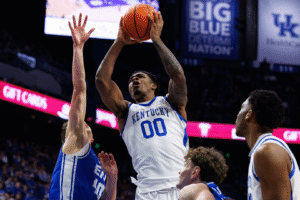
Three years ago, Nijel Pack left Kansas State and signed a two-year NIL deal that paid him $400,000 per season to play at Miami. It made him, at that point, the highest-paid player in college basketball and predictably precipitated geyser-like response. Shock, awe, cynicism, celebration, criticism, admiration, you name it.
Pack’s publicly disclosed contract by a high-profile Miami booster made national news and signaled a dam-breaking event amid an uncertain, fledgling era of college athletics that guaranteed one thing and one thing only: NIL agreements would get exponentially more excessive in the years to come. All the way back in 2022, it was hard for some people to wrap their minds around the idea of a college basketball player with minimal name recognition earning a $400K/year contract.
Three years later, the size of Pack’s payday barely registers as a headline-worthy transaction in college athletics.
Here’s what $400,000 will get you for one season in 2025: a mid-major guy who averaged fewer than 10 points on a non-NCAA Tournament team. This isn’t hypothetical; that very thing has already happened multiple times in recent weeks.
Nowadays, the sport is producing millionaire players on the regular.
Piloting through the portal to roster-build has never been more cumbersome — yet simple. The more money you have relative to the schools you are competing against, the easier it is to recruit the players you covet most.
More than 2,000 men’s Division I basketball athletes entered the portal in the past three-plus weeks (it closes April 22). Almost all have done so to achieve a better situation and, most importantly, find more money. That is what is driving the overwhelming number of these transfers. Money, money, money … and more money.
Five years ago, more than 4,400 Division I men’s basketball players were legally and collectively paid a grand total of $0 in NIL earnings. That number…
..






